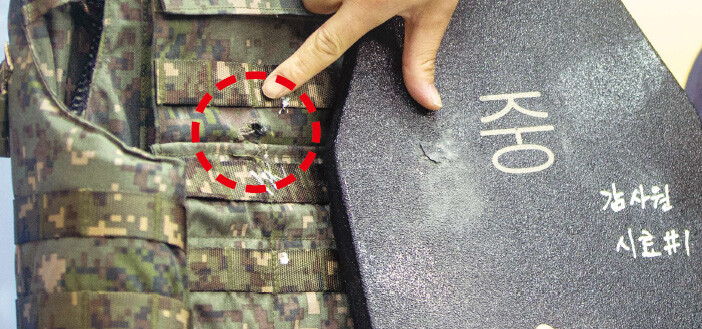hankyoreh
Links to other country sites 다른 나라 사이트 링크
Defense Ministry with evasive response on problematic body armor program

The Ministry of National Defense responded to Board of Audit and Inspection (BAI) findings on procurement improprieties that resulted in soldiers being supplied with body armor vulnerable to armor-piercing bullets. But its response was less about remorse and alternative solutions - and more about twisting the facts.
Speaking at a regular briefing on Mar. 24, Logistics Management Bureau Chief Park Byeong-gi cited three reasons for the cancellation of a project to introduce liquid body armor capable of stopping armor-piercing bullets: price, weight, and constraints on wearer activities.
The first issue Park mentioned was the price.
“The production price suggested by the Agency for Defense Development (ADD) was around 1.03 million won (US$880),” he said of the liquid body armor.
“The older form of body armor that was being procured at the time cost 460,000 won (US$390), while the new [ordinary] body armor currently being procured cost 800,000 won (US$680) in 2015,” he added.
Park’s claims contradict the findings announced on Mar. 23 by the BAI, which claimed the liquid body armor cost 820,000 won (US$700), or less than the 840,000 won (US$720) price tag for ordinary body armor by Samyang Chemtec.
But Hankyoreh reporting on Mar. 25 uncovered evidence that the ministry’s explanation tweaked the pricing standards along more self-serving lines. The Samyang Chemtec ordinary body armor supplied to front-line troops has plating only on its front side. Even the BAI’s price comparison considered only the front-side protection for the liquid and ordinary body armor types.
But the ministry’s figure of 1.03 million won assumed the presence of protection on both sides only for the liquid body armor.
Second, Park claimed the liquid body armor was “extremely heavy.”
“I don’t know for certain how many kilograms the liquid body armor weighs, but special forces anti-terror body armor with similar performance weighs around 10.5 kg,” he said.
Park went on to say there was “a difference of nearly two times” in weight between the liquid body armor and the ordinary body armor, which weighs 5.8 kg.
But the BAI reported a weight difference of just 0.1 kg between the two types. If true, this means that if the ordinary body armor weighs 5.8 kg as the ministry claimed, the liquid body armor would only weigh 5.9 kg.
Third, the ministry cited “combat inefficiency,” claiming the liquid body armor “was deemed incapable of allowing firing from prone positions or shoulder launches.”
In response, the BAI said on Mar. 25 that the issue “could not be verified.” Specifically, it said it had no basis for a conclusion because the liquid body armor project was halted before the testing and assessment stage when operational issues could actually be examined.
On Oct. 24, 2011, the ADD requested that the Defense Acquisition Program Administration (DAPA) conduct testing and assessment for military application of the liquid body armor. DAPA ultimately concluded its procedures on Dec. 7 of that year without conducting testing and assessment or adopting any related measures.
By Kim Ji-eun, staff reporter
Please direct questions or comments to [english@hani.co.kr]

Editorial・opinion
![[Editorial] Does Yoon think the Korean public is wrong? [Editorial] Does Yoon think the Korean public is wrong?](https://flexible.img.hani.co.kr/flexible/normal/500/300/imgdb/original/2024/0417/8517133419684774.jpg) [Editorial] Does Yoon think the Korean public is wrong?
[Editorial] Does Yoon think the Korean public is wrong?![[Editorial] As it bolsters its alliance with US, Japan must be accountable for past [Editorial] As it bolsters its alliance with US, Japan must be accountable for past](https://flexible.img.hani.co.kr/flexible/normal/500/300/imgdb/original/2024/0417/6817133413968321.jpg) [Editorial] As it bolsters its alliance with US, Japan must be accountable for past
[Editorial] As it bolsters its alliance with US, Japan must be accountable for past- [Guest essay] Amending the Constitution is Yoon’s key to leaving office in public’s good graces
- [Editorial] 10 years on, lessons of Sewol tragedy must never be forgotten
- [Column] A death blow to Korea’s prosecutor politics
- [Correspondent’s column] The US and the end of Japanese pacifism
- [Guest essay] How Korea turned its trainee doctors into monsters
- [Guest essay] As someone who helped forge Seoul-Moscow ties, their status today troubles me
- [Editorial] Koreans sent a loud and clear message to Yoon
- [Column] In Korea’s midterm elections, it’s time for accountability
Most viewed articles
- 1[Column] The clock is ticking for Korea’s first lady
- 2Samsung barricades office as unionized workers strike for better conditions
- 3[Editorial] When the choice is kids or career, Korea will never overcome birth rate woes
- 4[News analysis] After elections, prosecutorial reform will likely make legislative agenda
- 5S. Korea, Japan reaffirm commitment to strengthening trilateral ties with US
- 6Japan officially says compensation of Korean forced laborers isn’t its responsibility
- 7Why Israel isn’t hitting Iran with immediate retaliation
- 8[Editorial] Does Yoon think the Korean public is wrong?
- 9[Guest essay] How Korea turned its trainee doctors into monsters
- 10[Editorial] As it bolsters its alliance with US, Japan must be accountable for past